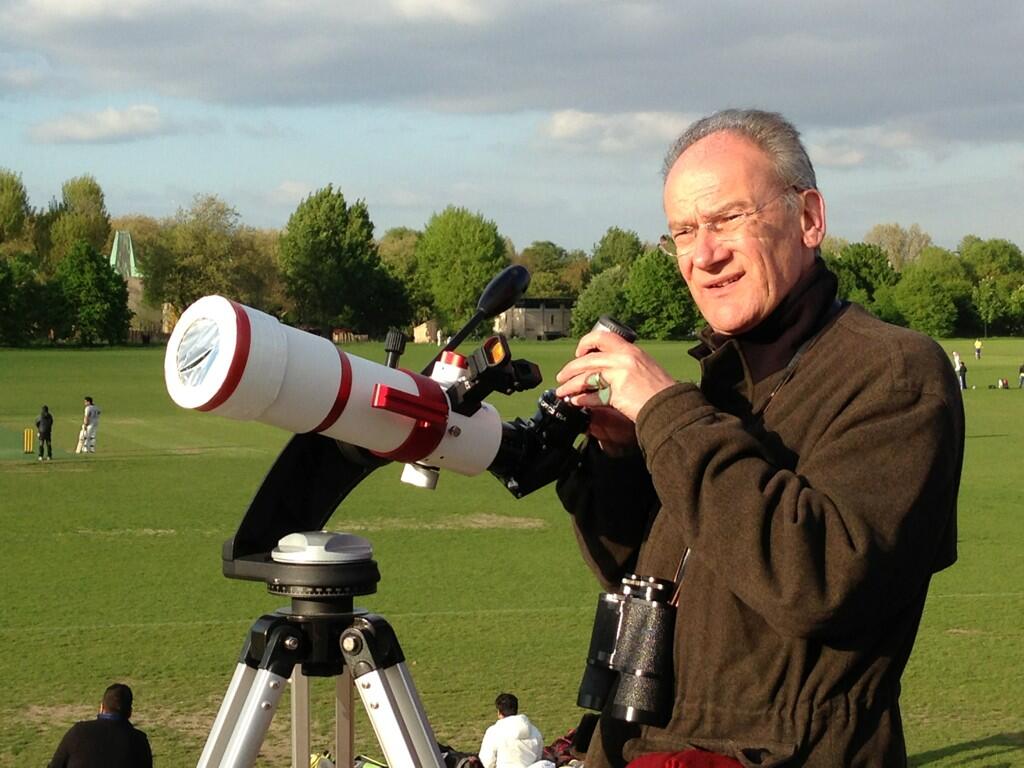AstroCamp May 2013.
This was the second AstroCamp at Cwmdu
campsite in the Brecon Beacons organised by the Baker Street Irregular
Astronomers and as the skies and weather were superb for the first event in Sep
2012 I was keen to attend the latest one. I prefer observing with my eyeballs
to imaging so I brought along a ‘shopping list’ of DSO targets to observe over
the long week-end. I booked an off-site ticket as soon as the event was
organised; I do not camp so, as before, I reserved a room at the local pub, The
Farmers Arms.
Friday, 3rd May.
 I, with two other Irregulars car sharing,
arrived following a four-hour car trip from Marylebone, to find the campsite
filling with Astros and their kit expectant of fine clear night-time skies.
There was time in the afternoon to set up the WO GT-81 on the AZ4
I, with two other Irregulars car sharing,
arrived following a four-hour car trip from Marylebone, to find the campsite
filling with Astros and their kit expectant of fine clear night-time skies.
There was time in the afternoon to set up the WO GT-81 on the AZ4
and contemplate some sunspot viewing using
my hand made solar film filter. Less than a minute of viewing elapsed before
the clouds enveloped the Sun to remain all evening and night.
Saturday, 4th May.
It had rained during the night and the
morning was grey and damp. But there was soon time for some morning solar
viewing as the skies cleared.
 |
| pic fom Spaceweather.com |
Active regions 11728 to 11739 were observed through
a Baader Astro SolarFilm filter at x48 (20mm Vixen NLV EP in a Celestron 2x
Barlow). AR11734 displayed an
interesting cat’s paw shape.
At 3pm it was time for the Astro Pub Quiz
in the pub where my current lack of astronomical knowledge was demonstrated
once again! By 6pm we were back in the camp field viewing Jupiter in the
western blue skies until Saturn rose in the East. After observing the two
planets easily seen from home in Marylebone I was keen to view a celestial
object not visible in the light polluted skies of Central London. For 2.5 hrs I observed a longed for target:
the Leo Triplet.
 |
| Leo Triplet - pic from Wikipedia |
I’ve never
observed them from London so I was determined to enjoy them in the dark skies
of the Brecon Beacons. M65 and M66 were delightful fuzzy ovals but NGC 3628
eluded my eyes. By 11:30 clouds had
arrived and so to bed satisfied with observing two Messiers unseen by me before.
Sunday, 5th May.
The skies were extremely clear as my
evening observing session started at 21:30 UT. I started on my list of DSOs I
can’t see from Central London. First up was M51, the Whirlpool Galaxy.
 |
| M51 - pic from NASA |
I located it using my manual setting
circles on my AZ4 mount from co-ordinates provided on my SkiSafari Pro app. At
x24 I could detect a rounded even silvery shape – of course nothing like the
detail seen in the image. I was pleased the evening started successfully.
22:09 UT - Next up was the Bodes galaxies,
M81 and M82. Again I’ve tried several times unsuccessfully to discern these in
London and was excited when both hove into view appearing as milky ovals at
24x.
 |
| M81 and M82. Image from astrobin.com |
21:32 UT – many fellow Astros were enjoying
the Great Globular Cluster in Hercules, M13, so I joined in with the excitement
and pointed the GT-81 at it and was pleased with the far greater detail than
when viewed from NW1.
 |
| M13. Image by NASA |
21:43 UT – I returned my attention and
scope toward the Leo Triplet. As during the previous evening not all three were
observed at x24 but the two Messiers: M65 and M66. The faintest NGC 3628 was again
a ‘no show’ to my curious eyes. The two oval smudges were a delight to
register. I felt my trip to the dark sky site had been worthwhile just to see
these.
Finally I returned to globular clusters and
spent time enjoying M53 at x24.
 |
| M53 pic from messier.seds.org |
I was pretty tired by 21:45 UT so decided
to relax in one of my astro-chairs with my 10x50 binoculars scanning the Realm
of Galaxies in Virgo. Dew arrived presently on oculars and objectives hampering
further observing by telescopes and I called it a night just before midnight.
Conclusion.
I went to Brecon Beacons for the dark
skies, to observe DSOs I cannot detect from Central London. I was delighted and
excited to see all I wanted to see in the skies. My experience has whetted my
appetite for the Canary Islands skies I shall be under in early June.



















.jpg)




